Facilities
Electrochemical Measurements
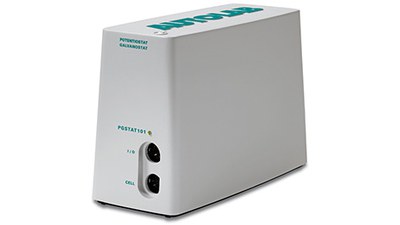
Potentiostat/Galvanostat (Metrohm, Autolab/PGSTAT101)
The Autolab/PGSTAT101 in combination with the powerful NOVA software can be used for most of the standard electrochemical techniques. Autolab/PGSTAT101 is an affordable potentiostat/galvanostat without compromising on quality and specifications, making it an ideal instrument for students and educational purposes. The small footprint allows you to place a high-quality potentiostat/galvanostat on a crowded workbench.
Specifications:
- Compliance voltage range: ±10 V;
- Current resolution: 0.0003% of current range;
- Input impedance: 100 GΩ;
- Maximum bandwidth: 1 MHz;
- Maximum current: ±0.1 A;
- Number of current ranges: 7;
- Number of current ranges remarks: 10 nA to 10 mA;
- Potential and current accuracy: V: ±0.2% ±2 mV and I: ±0.2% ±0.2% of current range;
- Potential range: –10 V to 10 V;
- Potential resolution: 3 μV (gain 100).
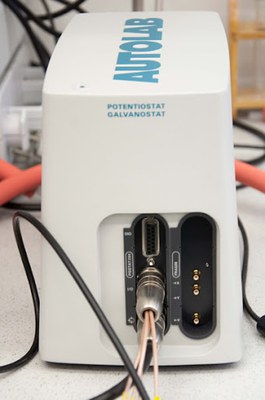
Potentiostat/Galvanostat (Metrohm, Autolab/PGSTAT204)
The PGSTAT204 combines a small footprint with a modular design. The instrument includes a base potentiostat/galvanostat with a compliance voltage of 20 V and a maximum current of 400 mA or 10 A in combination with the BOOSTER10A. The potentiostat is expanded with one additional module, the FRA32M electrochemical impedance spectroscopy (EIS) module. The PGSTAT204 is an affordable instrument that can be located anywhere in the lab and includes a built-in analog integrator. In combination with the powerful NOVA software, it can be used for most of the standard electrochemical techniques.
Specifications:
- Compliance voltage range: ±20 V;
- Current resolution: 0.0003% of current range;
- Input impedance: 100 GΩ;
- Maximum bandwidth: 1 MHz;
- Maximum current: ±0.4 A;
- Number of current ranges: 8;
- Number of current ranges remarks: 10 nA to 10 mA;
- Potential and current accuracy: V: ±0.2% ±2 mV and I: ±0.2% ±0.2% of current range;
- Potential range: –10 V to 10 V;
- Potential resolution: 3 μV (gain 100).
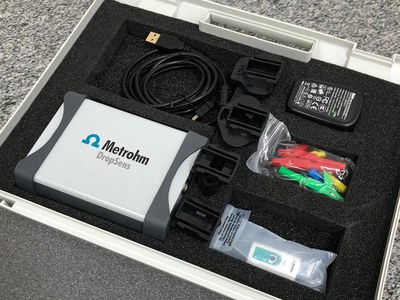
Portable (Bi)Potentiostat/Galvanostat/Impedance Analyzer (EIS) (Metrohm DropSens, μStat-i 400)
Metrohm DropSens provides you with a portable and wireless (Bi)Potentiostat/ Galvanostat/ Impedance Analyzer that can be used for Voltammetric, Amperometric, Potentiometric, and Electrochemical Impedance Spectroscopy (EIS) measurements. A complete solution for laboratory and fieldwork. Potentiostatic impedance measurements allow the definition of resistive and capacitive properties in the analyzed system. From corrosion to the detection of immunological binding events, EIS analysis offers a wide range of applications.
Specifications:
- Li-ion Battery (2300 mAh);
- Compliance voltage range: ±10 V;
- Current resolution: 0.025% of current range;
- Maximum current: ±0.04 A;
- Number of current ranges: 8;
- Number of current ranges remarks: 1 nA to 10 mA;
- Potential and current accuracy: V: ± 0.2% and I: ≤ 0.5% of current range;
- Potential range: –4 V to 4 V;
- Potential resolution: 1 mV;
- EIS frequency range: 1 mHz to 1 MHz;
- EIS current ranges: 1 nA to 100 mA;
- EIS open circuit potential: –3.5 V to 3.5 V.
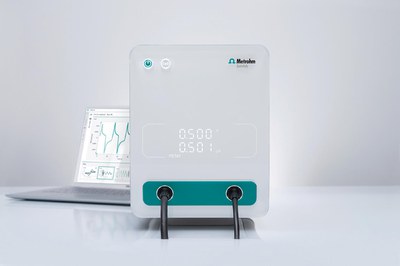
Potentiostat/Galvanostat (Metrohm, VIONIC)
VIONIC is the new generation potentiostat/galvanostat powered by Autolab's new INTELLO software. VIONIC offers the most versatile combinations of experimental possibilities, intelligent software, and the most complete data in a single configuration. VIONIC is the first potentiostat/galvanostat to offer a combination of all potential and current measurement functions, including leakage current measurement, polarization current measurement, and pulse current measurement.
Specifications:
- Compliance voltage range: ±50 V;
- Standard current: ±6 A;
- EIS frequency range: up to 10 MHz;
- Sampling interval: down to 1 μs.
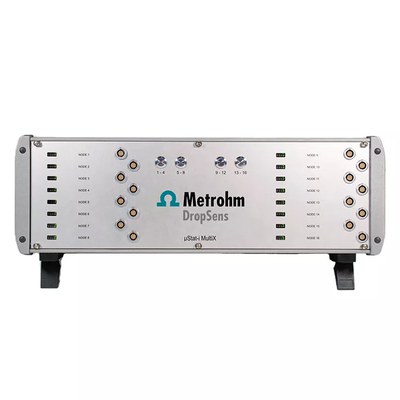
Multichannel bipotentiostat, galvanostat and impedance analyzer with MultiplEIS® (Metrohm DropSens, μStat-i MultiX)
Metrohm DropSens presents a multichannel bipotentiostat, galvanostat and impedance analyzer with MultiplEIS® technology (dual-channel Electrochemical Impedance Spectroscopy measurements) for multi-user and multi-disciplinary electrochemical research. Ensure the success of your projects with a complete solution that adapts to your current and future needs and keeps pace with your R&D team. Optimize your research and multiply your results working with up to 16 independent dual-channels (with MultiplEIS® technology). Measurements can be performed and analyzed with an advanced software and by remote connection. Increase the number of users (up to 16 users) working with one instrument at the same time in different applications. Efficiency, versatility and reliability in one instrument. Discover µStat-i MultiX.
Specifications:
- Operation modes: (Bi)Potentiostat/Galvanostat/Impedance Analyzer (EIS)
- Cell configuration: 2, 3 and 4 electrode configuration
- DC-Potencial Range: ±4 V
- Current ranges (potentiostat): ±1 nA to ±10 mA (8 ranges)
- Maximum measurable current: ±40 mA
- Potential ranges (galvanostat): ±100 mV, ±1 V (2 ranges)
- Applied Potential Resolution: 1 mV
- External inputs/outputs: 2 Analog inputs, 1 Analog output, 2 Digital input/outputs
- EIS Frequency Range: 1 mHz to 1 MHz
- AC Amplitude Range: 1 mV to 0.350 V rms (1.0 V p-p)
- Current ranges (EIS): ±1 nA to ±100 mA (9 ranges)
- DC fix potential or OCP: -3.5 V to 3.5 V
Devices Manufacturing
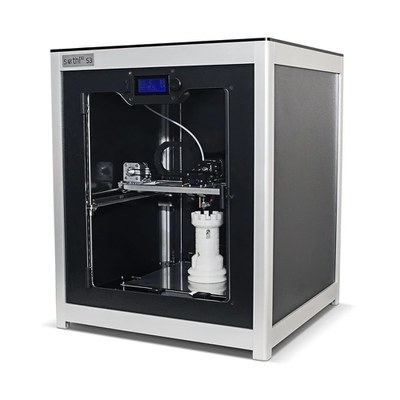
FDM 3D Printer (Sethi3D, S3)
The Fused Deposition Modeling technique (FDM), also known as Fused Filament Fabrication (FFF), is the most widely used type of 3D printing at the consumer level. FDM 3D printers work by extruding thermoplastic filaments, such as ABS (Acrylonitrile Butadiene Styrene) and PLA (Polylactic Acid), through a heated nozzle, melting the material and applying the plastic layer by layer to build a platform. Each layer is laid down one at a time until the part is complete. FDM 3D printers are well-suited for basic proof-of-concept models, as well as quick and low-cost prototyping of simple parts, such as parts that might typically be machined.
Specifications:
- Technology: Fused Deposition Modeling (FDM);
- Nozzle: stainless steel nozzle with 0.4 mm outlet;
- Layer height: 0.3 mm to 0.05 mm (300 to 50 microns);
- Printing speed: up to 150 mm s–1;
- Printing bed: heated aluminum bed with glass top (up to 140 °C);
- Travel speed: up to 300 mm s–1;
- Filament diameter: 1.75 mm;
- Printing filaments: ABS, PLA, PETG, TPU, among others;
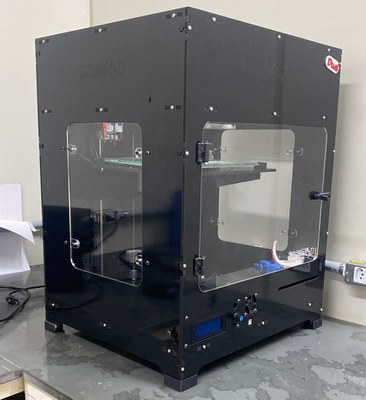
FDM Dual Extrusion 3D Printer (GTMax3D, Pro Core A1 Dual)
In the early days of 3D printing, with only one nozzle, FDM manufacturers could only print one material at a time. With the development of dual extrusion technology in recent years, manufacturers now can print parts composed of two or more materials. The dual extruder printing process is the same as a "regular" single extruder FDM 3D printer. The only difference is that the printer will automatically switch filaments at set times. GTMax3D's Pro line are printers aimed at productivity and ease of use. Having much more quality, speed, and ease of printing with large print volume, they can print large pieces or print several pieces at once.
Specifications:
- Technology: Fused Deposition Modeling (FDM);
- Nozzle: Dual extrusion with dual nozzle (nozzle diameter from 0.25 mm up to 1.0 mm);
- Layer height: 0.32 mm to 0.02 mm (320 to 20 microns);
- Printing speed: up to 200 mm s–1;
- Printing bed: heated aluminum bed with glass top (up to 140 °C);
- Filament diameter: 1.75 mm;
- Printing filaments: ABS, PLA, PETG, NYLON, PP, among others;
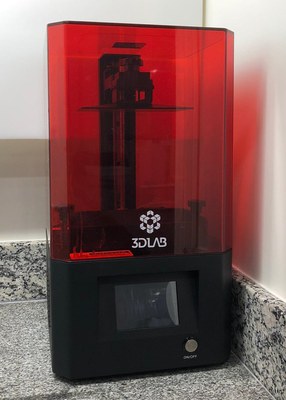
Resin 3D Printer (Creality, LD-002H)
Resin 3D printing, also known as vat polymerization, involves a photosensitive resin cured by a light source to produce solid layers and, eventually, whole parts. The resin is contained within a vat, or tank, and is cured against a build platform, which slowly rises out of the tank as the part is formed. The LCD 3D printing technology uses a UV light source from an array of LEDs (Light-Emitting Diodes) that is emitted through an LCD screen. Therefore, the screen only lets the light pass through areas that are to be cured, simplifying the process and removing the need for any moving parts. It is a simpler more and robust construction, relatively easy to assemble. Because this light is not expanded, pixel distortion is less of an issue with LCD printing. What this means is that the printing quality of an LCD printer depends on its LCD density. The more pixels it has, the better the print quality.
The Creality LD-002H 3D printer allows you to print different sizes of models, is adaptable for dental modules & samples, suitable for 3D printing business start-ups and 3D printed manufacturers.
Specifications:
- Technology: Liquid Crystal Display (LCD);
- Layer height: 0.03–0.05 mm;
- Screen: 2K 3.5" touch screen;
- Screen resolution: 1620 x 2560;
- Printing speed: 1–4 s/layer;
- XY axis precision: 0.051 mm;
- Uplift speed: 50–200 mm min–1;
- Rated power: UV integrated lamp beads (wavelength = 405 nm);
- Light energy: 8000 μW/cm²;
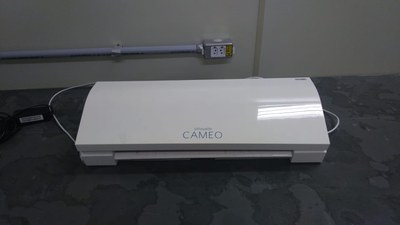
Cutting Machine (Silhouette, CAMEO 3)
The Silhouette CAMEO 3 is the ultimate DIY machine. It plugs into your PC or Mac with a simple USB cable and uses a small blade to cut over 100 materials, including paper, cardstock, vinyl, and fabric up to 30.5 cm wide and 3 m long. When you replace the blade with a pen, the CAMEO can also sketch and ink stipple. The machine can register and cut printed materials and is PixScan™ compatible.
Specifications:
- Maximum cutting area: 12 in. x 24 in. (30.5 cm x 61 cm) with a cutting mat and 12 in. x 10 ft. (30.5 cm x 3m) with a lined media;
- Maximum media thickness: 78.75 mils (2 mm);
- Maximum cutting force: 210 gf (2.06 N);
- Compatible media types: vinyl, heat transfer material, cardstock, photo paper, copy paper, rhinestone template material, fabric, and more;
- Cutting Blade: Silhouette AutoBlade;
- 12-inch cutting mat: 12.75 in. x 13 in. (32.4 cm x 33 cm).
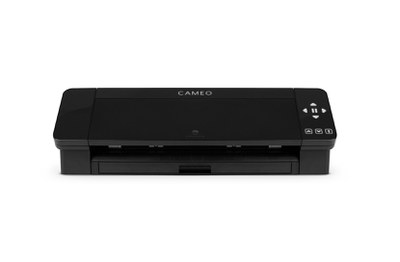
Cutting Machine (Silhouette, CAMEO 4)
With more speed and power than any other Silhouette machine, the CAMEO 4 is a desktop cutting machine for the modern maker. With certain materials, you can choose to cut from a mat or go completely matless using CAMEO 4's smart cutting technology. You can cut directly from a roll using the built-in roll feeder and cross-cutter. Cut out or sketch on dozens of materials such as vinyl, cardstock, fabric, and more.
Specifications:
- Maximum cutting area: 12 in. x 24 in. (30.5 cm x 61 cm) with a cutting mat and 12 in. x 10 ft. (30.5 cm x 3m) with a lined media;
- Maximum media thickness: 118.11 mils (3 mm);
- Maximum cutting force: 210 gf (2.06 N) in carriage 1 and 5 kgf (49 N) in carriage 2;
- Compatible media types: vinyl, heat transfer material, cardstock, photo paper, copy paper, rhinestone template material, fabric, and more;
- Cutting Blade: Silhouette AutoBlade;
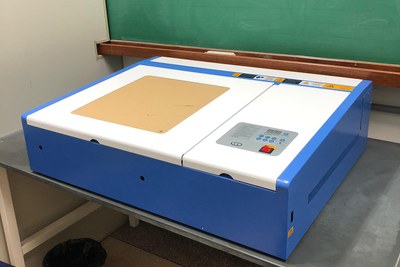
CNC Router Laser Cutting and Engraving Machine (Nagano, NCRL4040G)
The CNC Laser Cutting and Engraving Machine from Nagano can make cuts and engravings in various types of materials, such as acrylic, glass, wood, leather, plastic, MDF, and so on. It has a CO2 laser tube with a power of 50 W and a workspace of 40 cm x 40 cm. This tube is water-cooled with a "water flow sensor" system, which enables continuous work without losing cutting/engraving efficiency in conjunction with the external water pump (this helps in the circulation of water in laser, keeping it refrigerated at an ideal working temperature.
Specifications:
- Laser type: CO2;
- Laser power: 50 W;
- Workspace: 40 cm x 40 cm;
- Gross Power: 850 W;
- Maximum engraving speed: 600 mm s–1;
- Maximum cutting speed: 100 mm s–1;
- Accuracy: < 0.01 mm;
- Resolution: 0.0125 mm;
- Minimum character molding: 1 mm x 1 mm;
- Driving system: stepper motor;
- Laser tube cooling: external water pump;
- Applicable materials: acrylic, glass, crystal, wood, cardboard, cloth, leather, polyester, rubber, EVA, felt, ceramics, tiles, bamboo products, etc.
Materials Synthesis
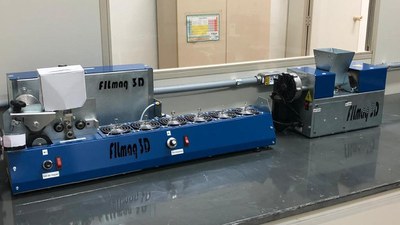
Extrusion System (Extruder – Filmaq3D, CV / Cooler and Tractor – Filmaq3D, FTR1 / Winder – Filmaq3D, FE1)
The Filmaq3D extrusion system makes it possible to save up to 90% compared to the purchase cost of virgin filament and 3D printed parts cost almost nothing. The Filmaq3D extrusion system performs the production of filament on-demand, so there is no material waste, in addition to producing any amount of filament in the color of interest. It is environmentally friendly as its energy consumption is similar to a desktop computer.
Specifications:
- Programmable temperature controller: maximum temperature 400 °C;
- Extrusion rate: 2.2 m min–1 or 350 g of filament per hour;
- Filament: 1.75 mm and 3.0 mm or any other size with custom nozzle;
- Types of plastic: ABS, PLA, EVA, PPHD, PETG, biofilaments;
- Material inlet size: up to 3.5 mm pellets.
- Feed screw speed: 0 to 30 RPM;
- Strength: ~500 W;
- Noise: 57 Hz at full power.
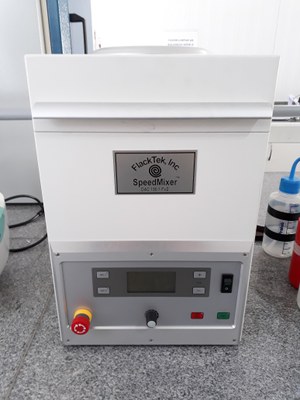
Dual Asymmetric Centrifuge SpeedMixer (FlackTek Inc., DAC 150.1 FVZ-K)
The SpeedMixer works by spinning a high-speed-mixing arm in one direction while the basket rotates in the opposite direction (thus, the name – Dual Asymmetric Centrifuge). This combination of forces in different planes enables incredibly fast mixing, and the precision construction of each machine gives it a balance that allows hushed operation. The SpeedMixer is bladeless, which results in bubble-free mixing with no clean-up required. Also, it offers an outstanding performance that is reliable and repeatable. The main current applications are for lab screening of development formulations and formulations components, for quality assurance testing, for and small-volume production. The incredible speed of mixing/grinding allows a complete sealant, coating, plastisol, or adhesive batch to be made in less than 5 minutes. The SpeedMixer is helpful for 1- or 2-part silicones, polyurethanes, polysulfides, acrylics, and a wide range of other materials.
Specifications:
- Speed: variable 300–3500 RPM;
- Mixing time: 5 seconds to 5 minutes;
- Mixing capacity: 5 g to 100
- Voltage/frequency: 110 V / 60 Hz;
- Power consumption: 500 W.
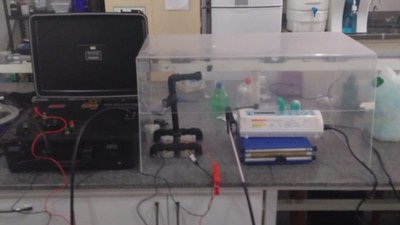
Electrospinning System (INSTRUM, HIPOT 60 kV 5 mA DC / RZ Equipamentos Veterinários, RS700 Vet)
The electrospinning system is equipped with an INSTRUM HIPOT 60 kV 5 mA DC high voltage generator and an RZ Equipamentos Veterinários RS700 Vet veterinary syringe pump. The HIPOT 60 kV 5 mA DC is a portable instrument for applied voltage tests in direct current, used in applied voltage tests for insulation tests on cables, capacitors, and insulators in general. It is designed to be easily used with maximum safety and mounted in a suitcase-style cabinet, with a strong and light structure, resistance to impacts, with maximum protection for both the instrument and its operator.
Specifications:
- High-voltage generator:
- Supply: 220 Vac. / 60 Hz;
- Maximum supply consumption: 1.5 A;
- 2 protection fuses: 2A / 250 Vac. ;
- Output polarity: negative;
- Power: 300 W;
- Current and voltage indicators:
- kV-DC:
- Range: 0–60 kV;
- Resolution: 0.1 kV;
- Disarm: –;
- Class: 1.5% ± 3 digits;
- mA-DC:
- Range: 0–5.0 mA;
- Resolution: 10 μA;
- Disarm: Disarms at 5.5 mA;
- Class: 1.5% ± 3 digits;
- μA-DC:
- Range: 0–1999 μA;
- Resolution: 1.0 kV;
- Disarm: Disarms at 1999 μA;
- Class: 1.5% ± 3 digits;
- kV-DC:
- Veterinary Syringe Pump:
- Screen: 3.2" LCD;
- Syringes: 10, 20, 30, and 50/60 mL;
- Environmental conditions: Temperature (5 ºC to 40 ºC); Relative humidity (15% to 95%); Pressure (70.0 to 106.0 kPa);
- Infusion mode: flow, volume x time, weight x concentration and dose;
- Infusion ranges: 0.1 - 300 mL/h (10 mL syringe)
0.1 - 600 mL/h (20 mL syringe)
0.1 - 900 mL/h (30 mL syringe)
0.1 - 2000 mL/h (50/60 mL syringe) - Total volume to infuse: 0.1 - 999.9 mL (step of 0.1mL)
- Total time to infuse: 00:00 - 99:59 (h:m) adjustable with a step of 1 minute;
- Accuracy; Mechanics < 1%, including syringe < 2%.
- Keep Vein Open: 0.1 - 2.5mL/h (adjustment by the operator)
- Bolus: 300.0 mL/h (10 mL syringe)
600.0 mL/h (20 mL syringe)
900.0 mL/h (30 mL syringe)
1500.0 mL/h (50/60 mL syringe) - Purge: 300,0 mL/h (10 mL syringe)
600,0 mL/h (20 mL syringe)
900,0 mL/h (30 mL syringe)
1500,0 mL/h (50/60 mL syringe) - Occlusion: 3 levels of adjustment by the operator.
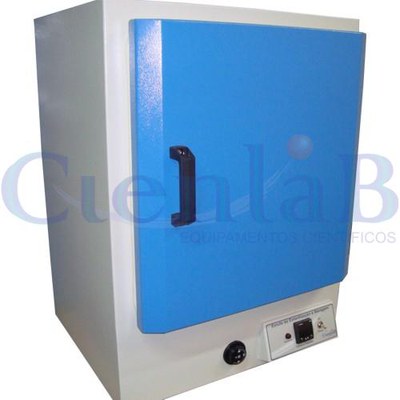
Digital Sterilization and Drying Oven (CIENLAB, CE-205/81)
The CE-205/81 Digital Sterilization and Drying Oven, manufactured by CIENLAB, is a high-performance laboratory equipment designed for precise temperature control and reliable sterilization or drying processes. This model features advanced digital controls, ensuring consistent heating and accurate temperature adjustments, making it ideal for various scientific, industrial, and medical applications. Its robust construction and efficient design provide uniform temperature distribution, enhancing the reliability and reproducibility of results.
Specifications:
- Cabinet made of 1020 steel with anti-corrosive electrostatic paint;
- Internal chamber made of 1020 steel with anti-corrosive electrostatic paint;
- Door seal with silicone profile installed around its entire perimeter;
- Thermometer holder on the top;
- Upper device made of AISI 304 steel to regulate vapor exhaust;
- Insulation of the internal chamber in glass wool, including on the door) with a thickness of 4 cm;
- Door with injected handle type handle;
- Shielded tubular resistance made of stainless steel;
- Digital microprocessor temperature control, with auto-tuning for PID parameters;
- Dual display type temperature display;
- PT 100 temperature sensor encapsulated in stainless steel;
- Safety system through analog bimetallic thermostat;
- Power supply: 110 or 220 volts;
- Working Range (Temperature): 7ºC above ambient to 200ºC degrees, resolution 0.1ºC;
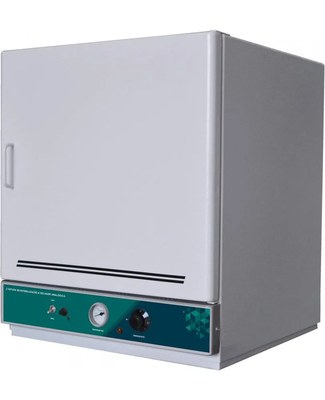
Analog Sterilization and Drying Oven (SolidSteel, SSA-110L)
The SSA-110L Analog Sterilization and Drying Oven by SolidSteel is a robust and reliable solution for laboratory sterilization and drying needs. Built with a durable stainless steel interior (AISI 430) and an SAE 1020 carbon steel exterior with anti-corrosive epoxy coating, it ensures long-lasting performance. This model features analog temperature control with an electromechanical thermostat, operating within a range of 50°C to 250°C. Its natural convection system provides uniform airflow, while the silicone gasket ensures high-temperature sealing. Designed for efficiency and ease of use, it is an excellent choice for professional and industrial applications.
Specifications:
-
Working temperature: 50°C to 250°C
-
Temperature control: Analog – electromechanical thermostat
-
Process indication: Pilot light
-
Power cord: With 3-pin plug, two phases and one ground, NBR 14136 compliant
-
Heating system: Shielded resistance
-
Thermal insulation: Glass wool, including the doors
-
System accuracy: +/- 25°C
-
Air circulation: Natural convection, noise-free
-
Power supply: Bivolt up to 150L, larger capacities require 110V or 220V specification
Cabinet:
- SAE 1020 carbon steel sheet;
- Epoxy textured electrostatic painting with anti-corrosive treatment;
- Door with ergonomic handle and right-side opening;
- Internal chamber made of AISI 430 stainless steel;
- Top vent – for gas release, moisture escape, or thermometer placement;
- Internal rails for tray movement;
- Roller-type locking system;
- High-temperature silicone gasket sealing.
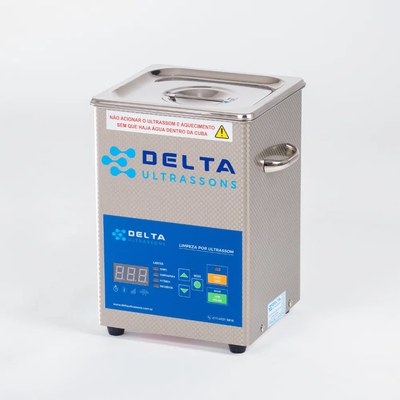
Ultrasonic Tank (Delta Ultrassons, Tabletop 402 DA)
The Tabletop 402 DA Ultrasonic Tank by Delta Ultrassons is a compact and efficient cleaning system designed for precision cleaning in laboratories and industrial settings. Featuring advanced ultrasonic technology, it ensures thorough removal of contaminants from delicate or complex surfaces without causing damage. The model offers user-friendly controls, a durable stainless steel tank, and optimized frequency settings for effective cleaning. Its tabletop design makes it ideal for small spaces, providing reliable performance for applications such as cleaning tools, instruments, and electronic components.
Specifications:
- 100% stainless steel equipment;
- Polished stainless steel tank;
- Stainless steel cabinet with decorative finish
- External dimensions 175 x 165 x 250 mm;
- Useful tank dimensions 150 x 137 x 150 mm;
- Basket dimensions 140 x 130 x 130 mm;
- Stainless steel lid;
- Voltage 220Vac 50/60Hz;
- Ultrasound Frequency 40Khz;
- Cannon-type ultrasound transducers, high performance and greater cavitation;
- Digital display for time and temperature adjustment (Fahrenheit / Celsius);
- Adjustable ultrasound frequency High and Low; Adjustable ultrasound power 25% to 100%;
- Digital display to monitor functions;
- Heating with digital control from 20 to 80 °C;
- Adhesive resistance fixed to the external wall of the tank;
Instrumentation
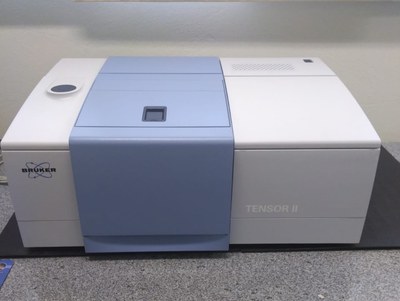
Fourier Transform Infrared Spectrophotometer (Bruker, TENSOR II) — MULTIUSER
The Fourier Transform Infrared (FTIR) spectrometry is a non-destructive, fast, and sensitive optical technique for detailed material, interface, and surface analysis. It provides information about the chemical structure of a sample, i. e. the presence of specific chemical groups, by probing the vibrational modes of the chemical bonds within molecules. The Bruker TENSOR II spectrophotometer is designed to combine the highest sensitivity and outstanding flexibility, with an intuitive and easy-to-operate interface.
Specifications:
- Spectral range: 8,000 to 340 cm−1, with standard KBr beamsplitter;
- Resolution: better than 0.4 cm−1;
- Wavenumber accuracy: better than 0.01 cm−1 @ 2,000 cm−1;
- Photometric accuracy: better than 0.1% T;
- Signal-to-noise: 5 Sec: > 6,000:1 (≤ 7.2 x 10−5 AU noise) peak-to-peak, 4 cm−1 resolution;
- Interferometer: RockSolid™, permanently aligned, high stability;
- Optics: gold-coated mirrors;
- Laser: diode laser with a long lifetime;
- IR-source: globar, electronically stabilized for a long lifetime;
- Detector: DigiTect™ detector system;
- Scan speed: 5 velocities, 1.4 – 51 mm/sec OPD (optical path difference);
- Spectra rate: optionally up to max. 25 spectra per second @ 16 cm−1 optical resolution;
- A/D converter: true 24-bit dynamic range for all scan velocities; dual channel data acquisition;
- Validation: IVU internal validation unit, fully automated OQ/PQ test and protocols;
- Aperture wheel: 11 positions, fixed diameters, ranging from 250 µm to 6 mm.
Techniques:
- Identification of raw materials;
- Drawing and search of chemical structures;
- Quantification of ingredients;
- Measurements with a mapping stage.
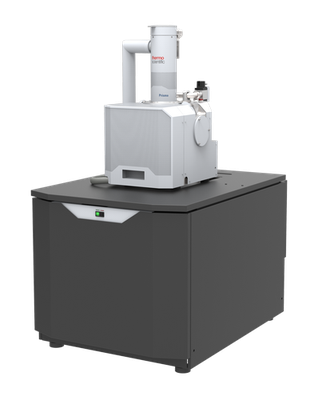
Scanning Electron Microscope (Thermo Fisher Scientific, Prisma E) — MULTIUSER
The crystallographic structure of materials, as well as their chemical composition and the binding states of the constituent chemical elements, are routinely analyzed and visualized in electronic microscopes at atomic, nanometric, and micrometric levels. Technological advances over the last few decades also allow the observation and analysis in situ of dynamic phenomena with increasing precision and reproducibility in atomic and nanometric dimensions. The Thermo Fisher Scientific Prisma E Scanning Electron Microscope (SEM) combines a wide array of imaging and analytical modalities with advanced automation to offer the most complete solution of any instrument in its class. It is ideal for industrial research and development, quality control, and failure analysis applications that require high resolution, sample flexibility, and an easy-to-use operator interface. The unique combination of accessible all-round performance, a large set of accessories, and the most intuitive elemental analysis with Thermo Scientific ColorSEM Technology make the Prisma E SEM the go-to SEM for microscale imaging and analysis in any industry or field.
Specifications:
Electron beam resolution:
- High-vacuum imaging:
- 3.0 nm @ 30 kV (SE);
- 8.0 nm @ 3 kV (SE).
- Low-vacuum imaging:
- 3.0 nm @ 30 kV (SE);
- 10 nm @ 3 kV (SE).
- ESEM:
- 3.0 nm @ 30 kV (SE).
Electron beam parameter space:
- Beam current range: up to 2 μA, continuously adjustable;
- Accelerating voltage range: 200 V – 30 kV;
- Magnification: 5 to 1,000,000x (Polaroid);
Chamber:
- Inside width: 340 mm;
- Analytical working distance: 10 mm;
- Ports: 12;
- EDS take-off angle: 35°;
- Three simultaneous EDS detectors are possible, two at 180°;
- Coplanar EDS/EBSD is orthogonal to the tilt axis of the stage.
Detectors:
- ETD — Everhart-Thornley SE detector;
- LVD — Low-Vacuum SE detector;
- GSED — Gaseous SED (used in ESEM mode);
- IR camera for viewing a sample in the chamber;
- RGB-CLD — real color cathodoluminescence (CL) detector.
ColorSEM Technology:
- Live SEM image coloring is available based on energy-dispersive X-ray spectroscopy (EDS). Point & ID, linescan, region, element maps, and accurate Noran quantification are included.
- EDS detector size: 10, 30, 60, or 100 mm2;
- Spectral resolution: 127 eV or 129 eV.
Vacuum system:
- 1 x 250 liter s–1 TMP, 1 x PVP;
- Beam gas path length: 10 mm or 2 mm;
- Evacuation time: ≤3.5 minutes to high vacuum and ≤4.5 minutes to ESEM;
- ESEM pressure: up to 2,600 Pa (H2O, default) or 4,000 Pa (N2, auxiliary gas kit required);
Sample Holders:
- Stage bias (beam deceleration): -4,000 V to +50 V;
- Stage: 5-axis motorized eucentric stage, 110 x 110 mm with a 105° tilt range;
- Repeatability: <3.0 μm (@ 0° tilt);
- Standard sample holder: standard multi-sample SEM holder uniquely mounts directly onto the stage, hosts up to 18 standard stubs (⌀ 12 mm), and does not require tools to mount a sample.
Image processor:
- Dwell time range from 50 ns – 25 ms/pixel;
- Up to 6144 x 4096 pixels;
- File type: TIFF (8-, 16-, 24-bit), JPEG, or BMP.
Techniques:
- ColorSEM: using live EDS (energy-dispersive X-ray spectroscopy) with live quantification, ColorSEM Technology transforms SEM imaging into a color technique. Any user can now acquire elemental data continuously for more complete information than ever before;
- Imaging hot samples: studying materials in real-world conditions often involves working at high temperatures. The behavior of materials as they recrystallize, melt, deform, or react in the presence of heat can be studied in situ with scanning electron microscopy or DualBeam tools;
- Environmental SEM: environmental SEM allows materials to be imaged in their native state. This is ideally suited for academic and industrial researchers who need to test and analyze samples that are wet, dirty, reactive, outgassing, or otherwise not vacuum-compatible;
- Particle analysis: particle analysis plays a vital role in nanomaterials research and quality control. The nanometer-scale resolution and superior imaging of electron microscopy can be combined with specialized software for the rapid characterization of powders and particles;
- Cathodoluminescence: cathodoluminescence (CL) describes the emission of light from a material when it is excited by an electron beam. This signal, captured by a specialized CL detector, carries information on the sample's composition, crystal defects, or photonic properties;
- Semiconductor analysis and imaging: Thermo Fisher Scientific offers microscopes for every function of a semiconductor lab, from general imaging tasks to advanced failure analysis techniques requiring precise voltage-contrast measurements.
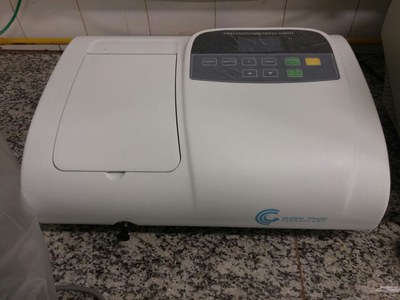
UV/VIS Spectrophotometer (Global Trade Technology, UV-5100)
Ultraviolet-visible (UV–visible, UV–VIS) spectrophotometry is primarily a quantitative analytical technique concerned with the absorption of near-UV (180–390 nm) or visible (390–780 nm) radiation by chemical species in solution. These regions of the electromagnetic spectrum provide energy that gives rise to electronic transitions. The UV-VIS UV-5100 Spectrophotometer features a large LCD screen allowing a display of calibration curves, saving groups of results, calibration curves with up to 8 points per curve, and correction factors for photometric reports. This spectrophotometer delivers an automatic wavelength selection function with wavelength fixed adjustment for changing the deuterium lamp, in addition to the individual activation function of the Deuterium lamp for wavelengths in the ultraviolet region and the Tungsten Halogen lamp for visible wavelengths.
Specifications:
- Optical system: single beam and diffraction grating of 1200 lines mm–1;
- Wavelength range: 190–1000 nm;
- Wavelength adjustment: automatic;
- Spectral bandwidth: 2 nm;
- Wavelength accuracy: ±1 nm;
- Wavelength repeatability: 0.5 nm;
- Photometric accuracy: ±0.5% T;
- Photometric repeatability: ≤0.3% T;
- Photometric range: 0–200% T; 0.3–3.0 Abs;
- Stray light: ≤0.3% T;
- Stability: ±0.002Abs/h @ 500 nm;
- Standard Cell Holder: 4-position cell holder 10x10 mm;
- Detector: Silicon photodiode;
- Display: LCD 128*64 (2.5");
- Scan speed: 340 nm/min.
Techniques:
- Photometric analysis: wavelength selection and Absorbance (Abs) and Transmittance (T) measurements;
- Quantitative analysis: allowing the construction of calibration curves with up to 8 standards and linear regulation with linearity coefficient;
- Kinetic analysis: verifying the trend of variation (absorbance and transmittance) of a sample, in a given time, in a fixed wavelength;
- Wavelength scanning: obtaining absorbance, transmittance, and concentration curves. Multiple spectrum curves can be displayed on the same graph. 3D spectrogram available;
- Multi-wavelength analysis: absorbance report at different wavelengths;
- DNA/Protein analysis: allowing quantitative analysis and purification tests of DNA and protein. Three calculation methods are available to choose from.
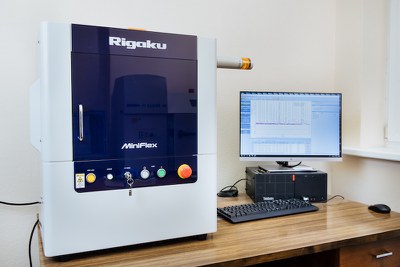
X-Ray Powder Diffractometer (Rigaku, MiniFlex 600) — MULTIUSER
The X-Ray Diffraction (XRD) technique is the main crystallographic analysis for determining the structure of materials as symmetry spatial group, network parameters, and microstructure. MiniFlex XRD system delivers speed and sensitivity through innovative technology advances, including the HyPix-400 MF 2D Hybrid Pixel Array Detector (HPAD) together with an available 600 W X-ray source and new 8-position automatic sample changer. This new direct photon counting detector enables high-speed, low-noise data collection and may be operated in 0D and 1D modes for conventional XRD analysis and 2D mode for samples with coarse grain size and/or preferred orientation.
Specifications:
HyPix-400 MF 2D hybrid pixel array detector (HPAD);
8-position automatic sample changer.
Software:
- Instrument control: Control & Measurement;
- Data analysis: PDXL.
X-Ray Generator:
- Maximum power: 600 W;
- Tube voltage: 40 kV;
- Tube current: 15 mA.
Shutter: rotary shutter linked to interlock.
X-ray tube: Cu.
Optics:
- Divergence slit: fixed or variable;
- Scattering slit: fixed;
- Receiving slit: fixed;
- Filter: Kβ foil filter;
- Monochromator: graphite;
- Soller slit: 5.0° or 2.5°.
Goniometer:
- Type: vertical;
- Radius: 150 mm;
- Scanning range: -3 to 145° (2θ);
- Scanning speed: 0.01 to 100° min–1 (2θ);
- Minimum step width: 0.005° (2θ);
- Accuracy: ±0.02°.
Detector:
- Scintillation counter: NaI scintillator;
- D/teX Ultra: high-speed silicon strip detector.
Techniques:
- Phase identification;
- Phase quantification (phase ID);
- Percent (%) crystallinity;
- Crystallite size and strain;
- Lattice parameter refinement;
- Rietveld refinement;
- Molecular structure.
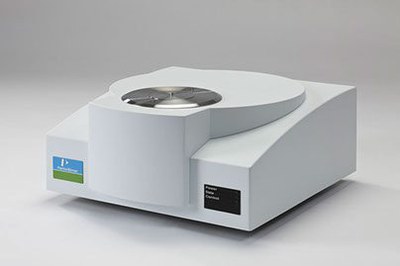
The TGA 4000 is designed with a compact ceramic furnace, which provides the temperature control you need for accurate results. Its rugged design is also corrosion resistant for the applications flexibility you need today and tomorrow.
Specifications:
- 21 CFR Part 11 Compatible: Yes
- Maximum Temperature: 1000 °C
- Model Name: TGA 4000
- Portable: No
- Technology Type: Thermal Analysis
- Warranty: 1 year
- Weight: 16.0 kg
Typical TGA Applications:
- Sample volatility
- Moisture content
- Oxidation stability
- Decomposition temperatures
- Carbon black content
- Performance of stabilizers
- Ash Content
Features & Benefits:
- High performance balance and furnace for accuracy and precision
- Top loading balance for easy sample load and unload
- Fast cooling for reduced cycle times and improving productivity
- Integrated mass flow controller extends applications flexibility
- Optional 45 position autosampler for unattended operation
- Easy-to-use Pyris software suite
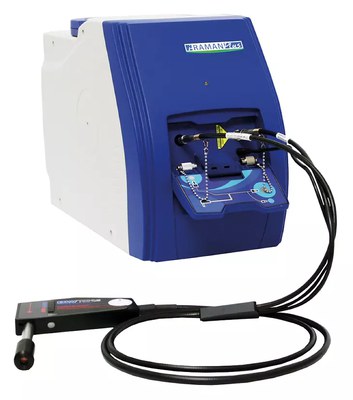
Portable Raman Spectrometer (Metrohm, i-Raman Plus 785S) — MULTIUSER
The i-Raman® Plus is part of our award winning line of i-Raman portable Raman spectrometers powered by our innovative smart spectrometer technology. Using a high quantum efficiency CCD array detector with deeper cooling and high dynamic range, this portable Raman spectrometer delivers an improved signal to noise ratio for up to 30 minutes of integration time, making it possible to measure weak Raman signals. The i-Raman Plus features the unique combination of wide spectral coverage and high resolution with configurations measuring from 65 cm-1 to up to 3400 cm-1. The system’s small footprint, lightweight design, and low power consumption provide research grade Raman capabilities anywhere. The i-Raman Plus comes equipped with a f iber optic probe, and can be used with a cuvette holder, a video microscope, an XYZ positioning stage probe holder and our proprietary BWIQ® multivariate analysis software and BWID® identification software. With the i-Raman Plus, a high precision qualitative and quantitative Raman solution is at your fingertips.
Specifications:
| Laser | Exiting Probe | At Laser Port |
|
532nm Excitation 785nm Excitation Laser Power Control |
30 mW, nominal 340 mW, nominal 0 to 100% (adjustable at 1% increments) |
42 mW, nominal 455 mW, nominal 0 to 100% (adjustable at 1% increments) |
|
Spectrometer |
Range | Resolution |
|
BWS465-532H BWS465-785S BWS465-785H |
65 - 3400cm-1 65 - 3350cm-1 65 - 2800cm-1 |
< 3.5 cm-1 @614nm < 4.5cm-1 @912nm < 3.5cm-1 @912nm |
|
Detector |
||
|
Detector Type CCD Temperature Integration Time |
High quantum efficiency CCD Array -2oC 100 ms - 30 mins |
|
|
Electronics |
||
|
Computer Interface Trigger |
USB 3.0 / 2.0 Yes (Compatible with B&W Tek Probes) |
|
|
Power Options |
||
|
DC Power Adaptor Battery |
12V DC @ 6.6 Amps Optional |
|
|
Physical |
||
|
Dimensions Weight Operating Temperature Humidity |
6.7 in x 13.1 in x 9.5 in (16.9 cm x 33.3 cm x 24.2 cm) ~11.0 lbs (~5.0 kg) 0oC - 35oC 10% - 85%, non-condensing |
|
Features:
Patented CleanLaze® technology for laser stabilization Rayleigh line cut-off of 65 cm-1 for low frequency modes Fiber-optic coupling for convenient sampling.
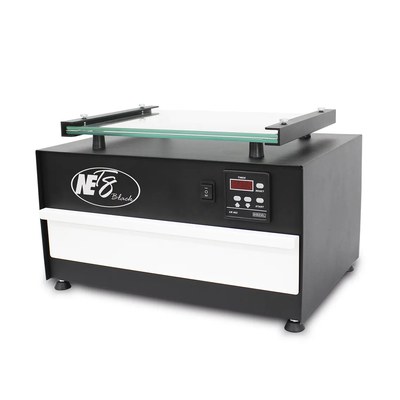
The NE T8 BLACK UV Chamber, Model A4, by NOVA ERA, is a high-performance exposure unit designed for UV light applications. This model features a dual exposure system with 8 UV lamps, ensuring even and consistent exposure across the surface. The NE T8 BLACK is ideal for various industrial and laboratory processes, such as screen printing and photopolymer applications. Its advanced design offers efficient energy use and high-quality results, making it a reliable tool for professionals requiring precise UV exposure. NOVA ERA Carimbos was the first company to manufacture a photopolymer exposure machine for stamps in Brazil. Since 1994, its equipment has been proven for quality, constantly renewed and continuously improved.
Specifications:
- Maximum plate size: 297 x 210 mm – A4;
- Dimensions and weight: 47.5 x 28 x 35 cm – 10.1 kg;
- Power supply: 110-220 V;
- Liquid polymer exposure: Two movable exposure glass plates 28 x 34 cm, polished, fixed with a clamping system;
- Exposure lamps: Two series with 8 UV 15W lamps, powered by electronic ballasts, programmed and controlled by an electronic timer;
- Structure: Fully metal;
- Finish: Epoxy paint;
- Interior: Completely black to prevent light dispersion on the polymer plate;
- Base: Adjustable feet for leveling;
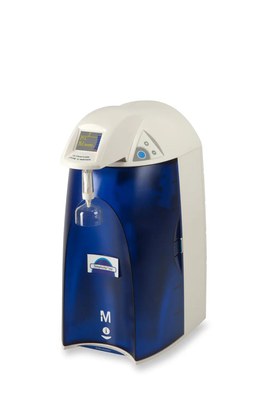
The Millipore Synergy UV Water Purifier by Millipore Corporation is a high-performance system designed to produce ultrapure water for laboratory applications. Featuring a UV lamp for the removal of organic contaminants and a comprehensive filtration process, the Synergy UV ensures water of the highest quality, free from microorganisms, endotoxins, and particulate matter. Its user-friendly interface allows for easy monitoring and customization of water quality, making it ideal for applications in research, analytical testing, and medical laboratories. The system combines reliability, efficiency, and advanced technology to meet the strict water purity standards required in scientific environments.
Specifications:
- Type of Feedwater: Elix, RO, distilled or DI water;
- Flowrate: ≥ 1.5 LPM (Litres per minute);
- Minimum Pressure: > 0 bar (Feed from a tank);
- Maximum Pressure: ≤ 0.5 bar;
- Temperature: 5 to 35 °C;
- Conductivity: < 100 μS/cm;
- TOC: < 50 ppb;
- Feedwater Piping Connection: 1/2 inch Male GAZ, NPTM or BSPM;
- Indoor Use Only;
- Storage Temperature: 5 °C < T < 40 °C;
- Operating Temperature: 5 °C < T < 40 °C;
- Relative Humidity: Should not exceed 80% for temperatures below 31 °C. Should stay within 50% to 80% between 31 °C and 40 °C;
- Altitude: < 3000 metres;
- Installation Category: II;
- Pollution Degree: 2;
- Resistivity: 18.2 MΩ.cm @ 25 °C;
- Total Organic Carbon (TOC): < 5 μg/L (ppb) (with UV), < 10 μg/L (ppb) (without UV);
- Micro-Organisms: < 1 CFU/ml (with Final Filter);
| SYSTEM | Synergy | Synergy UV |
| Operating Weight | 9.7 kg | 10.2 kg |
| Dry Weight | 6.7 kg | 7.2 kg |
| Shipping Weight | 12 kg | 12.5 kg |
Electrical:
- 100 VAC ± 10%, 50/60 Hz. 0.68 amp source, 2 amp T (Time Lag) fuse, Power = 100 VA
- 120 VAC ± 10%, 50/60 Hz. 0.60 amp source, 2 amp T fuse, Power = 100 VA
- 230 VAC ± 10%, 50/60 Hz. 0.37 amp source, 2 amp T fuse, Power = 100 VA

